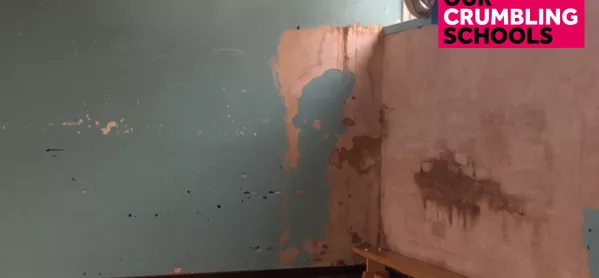- Home
- ‘Raindrops keep falling on our heads’: The reality of crumbling schools
‘Raindrops keep falling on our heads’: The reality of crumbling schools

As headteacher Tony Guise walks up the path to his school, he looks up at the grey, flat-roofed, 1960s structure and says “It’s grim, isn’t it?”
The school, which achieves some of the best results in its district, is looking to expand. But from the outside, Calder High in Calderdale looks like a downtrodden and uncared-for place.
Strong winds have blown a window out, causing part of the playground to be deemed out of bounds, while heavy rain has led to leaks, closed classrooms and lighting failures.
There is mould evident on the classroom walls; concrete windowsills are breaking away; and the sports facilities consist of two small rooms marked with damp.
The situation, says Mr Guise, is demoralising for everyone.
He tells Tes that the condition of school buildings is an aggravating feature of the school funding crisis. Schools are struggling to make ends meet and are having to balance rising staffing costs with the maintenance of buildings they cannot afford to fully fix.
“If all you do is patch and mend, your building estate is getting increasingly worse,” he says.
“As a headteacher, what do you do? Do you let your building go to rack and ruin in order to invest properly in teaching and learning? We are a school so we will always prioritise teaching and learning, but we are responsible for the building. It shouldn’t be a choice, but it is.”
‘The state of most school buildings is a disgrace’
Mr Guise is one of many heads who have taken part in a new survey on school buildings that has produced some stark findings.
The majority of headteachers who took part in the poll, by the Association of School and College Leaders and Tes, said their buildings are not fit for purpose and they do not have enough money to carry out even essential repairs.
And almost half said they have been forced to close part of their site because of problems with the building.
Mr Guise’s concerns are echoed in schools across the country. Here are some of the comments made anonymously by heads in the survey:
- “We were next in line for the BSF [Building Schools for the Future] programme, and this was cancelled with the arrival of a new government. Since then, we scrabble around to keep the school in a safe state of repair.”
- “The state of most school buildings is a disgrace. We cannot even keep up with routine maintenance and need urgent funding.”
- “The students of the 21st century are being taught in the cracked, crumbling relics of a mid-20th century investment in school buildings. It is hard to raise aspirations when surrounded by dilapidation.”
- “We have made do for the past three years. We cannot continue to do so without substantial investment. We have windows that do not close properly, which has meant break-ins, as well as the normal wasting of energy.”
- “The buildings are not fit for purpose; many of our students and staff are cold in the winter and too hot in the summer.”
- “Seven years ago the capital funding was around £180,000 per annum for my school. This allowed for routine repairs and some refurbishment. For the past few years, the funding has been £27,000, which barely covers the cost of replacement PCs. The policy is shortsighted and is leading to major problems in terms of the quality of school buildings and equipment.”
- “Lack of sufficient funding is impacting on all aspects of educational provision, and we are unable to keep our buildings up to date and efficient. Parts of our building are reaching end-of-life stage with no hope of refurbishing sufficiently to meet long-term needs.”
- “Funding is not enough to maintain the fabric of our building. If there is a critical failure (eg, a boiler) I don’t know what we will do. We bid for Condition Improvement funding and we were unsuccessful - while we emptied the bucket in the staffroom.”
- “Asbestos provides a constant pressure on our school’s budget; no repair is minimal, every job is approached with trepidation. We recently received funding to enhance the building but it is wasted on investing in a building that needs replacing.”
These comments were provided in the survey of 221 school leaders, carried out at the end of the last academic year.
Keep reading for just £1 per month
You've reached your limit of free articles this month. Subscribe for £1 per month for three months and get:
- Unlimited access to all Tes magazine content
- Exclusive subscriber-only stories
- Award-winning email newsletters



